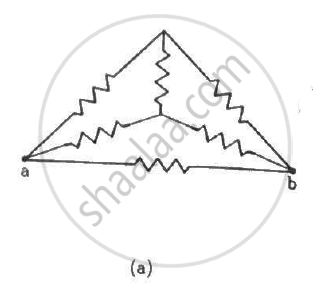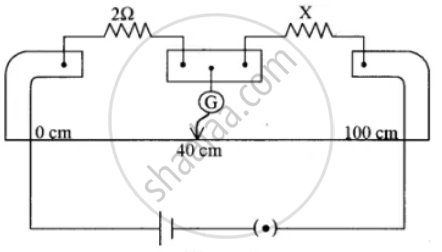Advertisements
Advertisements
प्रश्न
If the combination is connected to a battery of emf 20 V and negligible internal resistance, determine the current through each resistor, and the total current drawn from the battery.
उत्तर
Emf of the battery, V = 20 V
Current (I1) flowing through resistor R1 is given by,
I1 = `"V"/"R"_1`
= `20/2`
= 10 A
Current (I2) flowing through resistor R2 is given by,
I2 = `"V"/"R"_2`
= `20/4`
= 5 A
Current (I3) flowing through resistor R3 is given by,
I3 = `"V"/"R"_3`
= `20/5`
= 4 A
Total current, I = I1 + I2 + I3 = 10 + 5 + 4 = 19 A
Therefore, the current through each resister is 10 A, 5 A, and 4 A respectively and the total current is 19 A.
APPEARS IN
संबंधित प्रश्न
If the combination is connected to a battery of emf 12 V and negligible internal resistance, obtain the potential drop across each resistor.
Two electric bulbs P and Q have their resistances in the ratio of 1 : 2. They are connected in series across a battery. Find the ratio of the power dissipation in these bulbs
Three identical cells each of emf 2V and internal resistance 10 Ω are connected in series to form a battery. The battery is then connected to a parallel combination of two identical resistors, each of resistance 6 Ω. Find the current delivered by the battery.
Two resistors R1 = 400Ω and R2 = 20 n are connected in parallel to a battery. If heating the power developed in R1 is 25 W. find the heating power developed in R2
Find the equivalent resistance of the circuits shown in the figure between the points a and b. Each resistor has resistance r.


Two resistors of equal resistances are joined in series and a current is passed through the combination. Neglect any variation in resistance as the temperature changes. In a given time interval,
(a) equal amounts of thermal energy must be produced in the resistors
(b) unequal amounts of thermal energy may be produced
(c) the temperature must rise equally in the resistors
(d) the temperature may rise equally in the resistors
Two voltameters, one with a solution of silver salt and the other with a trivalent-metal salt, are connected in series and a current of 2 A is maintained for 1.50 hours. It is found that 1.00 g of the trivalent metal is deposited. (a) What is the atomic weight of the trivalent metal?
(b) How much silver is deposited during this period? Atomic weight of silver is 107.9 g mol−1.
Two resistors R1= 60 Ω and R2 = 90Ω are connected in parallel. If electric power consumed by the resistor R1 is15 W, calculate the power consumed by the resistor R2.
In a meter bridge circuit, resistance in the left-hand gap is 2 Ω and an unknown resistance X is in the right-hand gap as shown in the figure below. The null point is found to be 40 cm from the left end of the Wire. What resistance should be connected to X so that the new null point is 50 cm from the left end of the wire?

A current of 2 A flows in conductors as shown. The potential difference VA- VB will be ________.

An ammeter together with an unknown resistance in series is connected across two identical batteries each of emf 1.5 V. When the batteries are connected in series, the galvanometer records a current of 1A and when the batteries are in parallel, the current is 0.6A. Then the internal resistance of the battery is ______.
Combine three resistors 5 Q, 4.5 Q and 3 Q in such a way that the total resistance of this combination is maximum ______.
If two resistors of resistances R1 = (4 ± 0.5) Ω and R2 = (16 ± 0.5) Ω are connected in series. The eqivalent resistance with the limits of percentage error is ______.
How many times will the resistance of an identical conductor be increase, if the parallel resistance be change to series one?
Two electric lamps of each 40 watt are connected in series. The power consumed by the combination will be
Let there be n resistors R1............Rn with Rmax = max (R1......... Rn) and Rmin = min {R1..... Rn}. Show that when they are connected in parallel, the resultant resistance RP < R min and when they are connected in series, the resultant resistance RS > Rmax. Interpret the result physically.
An electric cable of copper has just one wire of radius 9 mm. Its resistance is 14Ω. If this single copper wire of the cable is replaced by seven identical well insulated copper wires each of radius 3 mm connected in parallel, then the new resistance of the combination will be:
A wire of uniform cross-section and resistance 4 ohms is bent in the shape of square ABCD. Point A is connected to point P on DC by a wire AP of resistance 1 ohm. When a potential difference is applied between A and C, the points B and P are seen to be at the same potential. What is the resistance of the part DP?

